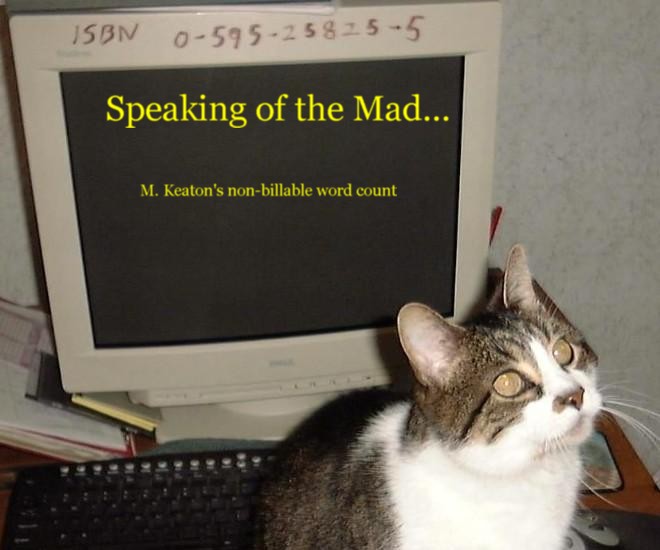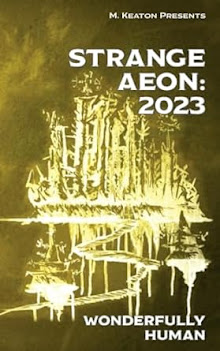We love old books.
The Mad King by Edgar Rice Burroughs
With the success of Burroughs’ series—Venus, Mars, Tarzan, Pellucidar—many of his self-contained novels have been overlooked and, while the others were reprinted, these other works allowed to fade from memory. Certainly, The Mad King deserves a better fate and is worth the effort to track down and acquire. Set at the turn of the nineteenth century, the book is best described with adjectives such as skullduggery and swashbuckling. In the timeframe, the sword is as useful as the single-shot revolver and a horse can be a more reliable means of transportation than an automobile. Within this setting, Burroughs is able to combine modern intrigue with individual heroism to achieve a maximum of adventure on top of a complex plot.
Like the more popular Prisoner of Zenda by Hope, Burroughs uses the plot mechanic of look-alike traveler and prince along with mistaken identity to put his pieces into play. The heroes are noble, women pure, and villains unambiguously evil—traits all to rare in most ‘modern’ literature and a refreshing change of pace.
Related Reading:
Edgar Rice Burroughs, any and all
Prisoner of Zenda by Anthony Hope
Graustark by George Barr McCutcheon
The Phoenix Guard by Steven Brust
Saturday, January 24, 2009
Wednesday, January 21, 2009
Dark Matter, New Wheels On the Wagon
"Hey, it's time again."
"Five more minutes."
"No, boss. Now. Wake up."
"I'm old, let me sleep. You're a cat, you should understand the importance of a solid 14 hours a day."
"Last one, I promise."
"Sure. Until next time. Do you have any idea how much hate mail I get?"
"It's good for your blood pressure. Now go."
"Fine, fine..."
A final problem:
Recent observations have indicated that the expansion rate of the universe is actually increasing, invalidating numerous previous assumptions and putting the theory of Quintessence (Ether) back into play. This problem has revitalized superstring theory (previously dismissed in the early 1970s in favor of Quantum chromodynamics) and bringing Maxwell's unification of electricity, magnetism, and light back to the fore of discussion.
At the root of the entire discussion is the blind assumption that Einstein's unified space-time continuum is correct. The sticking point is and always has been gravity.
So, let me offer a different theory altogether. It increasingly looks like Maxwell was right (I'd say it's just about a done deal at this point, as much as science can close a deal. Remember, science as a tool cannot prove anything. It only disproves things until we are left with a sufficiently limited scope of functioning theories.) It also is very possible that Einstein's general relativity is wrong and that Lorentzian Relativity (LR) is right. Now factor in the idea from quantum mechanics that there can be additional dimensions. (Last time I looked, we were up to a minimum of four and a maximum of eleven depending on which formula you need to make your math work for string theory. This is another area more rightly classified as pre-science than true science. It's early in the game still.)
LR allows faster-than-light propagation (a phenomenon already demonstrated experimentally back in about 2005) and it assumes time is not, in fact, inextricably bound with space into a single continuum. Time exists independently of space and therefore can, within certain boundaries, have an absolute value. (Remember, Einstein's theories of specific and general relativity are difference theories and Einstein himself proposed a universal constant.)
(I would like to side track here for a moment to observe that the clocks within all orbital GPS satellites are synchronized and have evidenced no time dilation despite years of different speeds. This should be impossible under general relativity and yet, as far as I know, this phenomenon has never been properly addressed.)
So, taking FTL propagation and space-time separation from LR and multiple dimensions from quantum mechanics and applying this against the observed gravimetric quandaries of Dark Matter, I ask, why not a second dimension of TIME rather than space. There has never been any reason to assume that extra dimensions must be spatial and the idea comes a lot closer to explaining the observed gravimetric data than making up an entire host of random magically invisible particles. What if the gravimetric effects that we cannot explain currently are because the force of gravity extends into a second temporal dimension? Mass (or more precisely masses) out of temporal phase with our universe would fit all the criteria of Dark Matter with fewer complications. It may very well be that gravity turns out to be the unifying universal force instead of the half-ignored, despised step-child that modern physics treats it as. Do I think my idea is the one true and perfect answer? Absolutely not. I do, however, think it deserves equal consideration with the other theories that have been presented and I also think that our blind subservience to the theory of general relativity has gone on long enough. Rather than build new castles in the air, it is time to re-examine the foundation beneath. Just as Einstein assaulted the orthodoxy of Newtonian physics, it is legitimate to question in turn the orthodoxy of Einstein.
Ah but what do I know? I'm just a crazy old man.
"Five more minutes."
"No, boss. Now. Wake up."
"I'm old, let me sleep. You're a cat, you should understand the importance of a solid 14 hours a day."
"Last one, I promise."
"Sure. Until next time. Do you have any idea how much hate mail I get?"
"It's good for your blood pressure. Now go."
"Fine, fine..."
A final problem:
Recent observations have indicated that the expansion rate of the universe is actually increasing, invalidating numerous previous assumptions and putting the theory of Quintessence (Ether) back into play. This problem has revitalized superstring theory (previously dismissed in the early 1970s in favor of Quantum chromodynamics) and bringing Maxwell's unification of electricity, magnetism, and light back to the fore of discussion.
At the root of the entire discussion is the blind assumption that Einstein's unified space-time continuum is correct. The sticking point is and always has been gravity.
So, let me offer a different theory altogether. It increasingly looks like Maxwell was right (I'd say it's just about a done deal at this point, as much as science can close a deal. Remember, science as a tool cannot prove anything. It only disproves things until we are left with a sufficiently limited scope of functioning theories.) It also is very possible that Einstein's general relativity is wrong and that Lorentzian Relativity (LR) is right. Now factor in the idea from quantum mechanics that there can be additional dimensions. (Last time I looked, we were up to a minimum of four and a maximum of eleven depending on which formula you need to make your math work for string theory. This is another area more rightly classified as pre-science than true science. It's early in the game still.)
LR allows faster-than-light propagation (a phenomenon already demonstrated experimentally back in about 2005) and it assumes time is not, in fact, inextricably bound with space into a single continuum. Time exists independently of space and therefore can, within certain boundaries, have an absolute value. (Remember, Einstein's theories of specific and general relativity are difference theories and Einstein himself proposed a universal constant.)
(I would like to side track here for a moment to observe that the clocks within all orbital GPS satellites are synchronized and have evidenced no time dilation despite years of different speeds. This should be impossible under general relativity and yet, as far as I know, this phenomenon has never been properly addressed.)
So, taking FTL propagation and space-time separation from LR and multiple dimensions from quantum mechanics and applying this against the observed gravimetric quandaries of Dark Matter, I ask, why not a second dimension of TIME rather than space. There has never been any reason to assume that extra dimensions must be spatial and the idea comes a lot closer to explaining the observed gravimetric data than making up an entire host of random magically invisible particles. What if the gravimetric effects that we cannot explain currently are because the force of gravity extends into a second temporal dimension? Mass (or more precisely masses) out of temporal phase with our universe would fit all the criteria of Dark Matter with fewer complications. It may very well be that gravity turns out to be the unifying universal force instead of the half-ignored, despised step-child that modern physics treats it as. Do I think my idea is the one true and perfect answer? Absolutely not. I do, however, think it deserves equal consideration with the other theories that have been presented and I also think that our blind subservience to the theory of general relativity has gone on long enough. Rather than build new castles in the air, it is time to re-examine the foundation beneath. Just as Einstein assaulted the orthodoxy of Newtonian physics, it is legitimate to question in turn the orthodoxy of Einstein.
Ah but what do I know? I'm just a crazy old man.
Sunday, January 18, 2009
Dark Matter, Nomenclatural Nightmares
"Shut up, cat, I got it."
And now,
Back to the theories:
WIMPs--Weakly Interacting Massive Particles. Mathematically, Sparticales must be significantly much more massive than their partners and interact only where very weak nuclear forces are involved. Thus, SUSY particles are often discussed as WIMP. Theoretically, WIMPs would have been formed during the big bang but, being unstable, decayed into lighter particles. This makes the most likely candidate for actual detection the LSP (lightest supersymmetrical particle) considered to be either the photino or something referred to as the neutralino (because it may be a quantum mixture of different neutral sparticles). It has been postulated that MACHOs may be comprised of WIMPs or that WIMPs permeate the universe to account for the matter discrepancy.
Neutrinos--A neutral charge particle of mass similar to that of an electron. Neutrinos have been tentatively detected through experiments within nuclear reactors. Neutrinos may make up a portion of Dark Matter but lack sufficient mass to account for the whole. Further, many astronomers now argue (based on cosmic background radiation) that Dark Matter cannot be baryonic matter. Neutrinos are actually fermionic but act similar enough to baryonic to remove them from contention as an explanation. Because of their properties, neutrinos would form hot Dark Matter and most astronomers (again based on the background radiation) believe Dark Matter must be cold. (Hot and cold referring to mass, interaction, etc.)
SIDM (also called SIMPs)--Self-Interacting Dark Matter (Strongly Interacting Massive Particles). Big fat WIMPs that react strongly instead of weakly, considered to be self-interacting because they have never been observed and therefore cannot be interacting with non-dark matter.
Q-Balls--Lumps of matter that may have formed when sparticles coagulated during the hot dense phase of the early big bang universe. The real fun of Q-Balls is not their possibility of explaining Dark Matter (very unlikely) but that they would blow up REAL good. These would be coagulated balls of squarks and sleptons that, rather than being the actual explosive themselves, would be a quantum catalyst. Fed by a proton stream, the internal sparticles of a Q-Ball would rip proton quarks apart, releasing the fundamental energy of the quarks (about 100X H-bomb yield).
Q-Balls are a good example of where the sci-fi writer in me takes a walk away from the critical scientist. As a theory, even the guys who came up with the idea of Q-Balls say it's highly unlikely and fairly weak. But as an idea to use in a story, it's rich with possibilities and it's scientifically plausible.
Next Time: Quintessence
And now,
Back to the theories:
WIMPs--Weakly Interacting Massive Particles. Mathematically, Sparticales must be significantly much more massive than their partners and interact only where very weak nuclear forces are involved. Thus, SUSY particles are often discussed as WIMP. Theoretically, WIMPs would have been formed during the big bang but, being unstable, decayed into lighter particles. This makes the most likely candidate for actual detection the LSP (lightest supersymmetrical particle) considered to be either the photino or something referred to as the neutralino (because it may be a quantum mixture of different neutral sparticles). It has been postulated that MACHOs may be comprised of WIMPs or that WIMPs permeate the universe to account for the matter discrepancy.
Neutrinos--A neutral charge particle of mass similar to that of an electron. Neutrinos have been tentatively detected through experiments within nuclear reactors. Neutrinos may make up a portion of Dark Matter but lack sufficient mass to account for the whole. Further, many astronomers now argue (based on cosmic background radiation) that Dark Matter cannot be baryonic matter. Neutrinos are actually fermionic but act similar enough to baryonic to remove them from contention as an explanation. Because of their properties, neutrinos would form hot Dark Matter and most astronomers (again based on the background radiation) believe Dark Matter must be cold. (Hot and cold referring to mass, interaction, etc.)
SIDM (also called SIMPs)--Self-Interacting Dark Matter (Strongly Interacting Massive Particles). Big fat WIMPs that react strongly instead of weakly, considered to be self-interacting because they have never been observed and therefore cannot be interacting with non-dark matter.
Q-Balls--Lumps of matter that may have formed when sparticles coagulated during the hot dense phase of the early big bang universe. The real fun of Q-Balls is not their possibility of explaining Dark Matter (very unlikely) but that they would blow up REAL good. These would be coagulated balls of squarks and sleptons that, rather than being the actual explosive themselves, would be a quantum catalyst. Fed by a proton stream, the internal sparticles of a Q-Ball would rip proton quarks apart, releasing the fundamental energy of the quarks (about 100X H-bomb yield).
Q-Balls are a good example of where the sci-fi writer in me takes a walk away from the critical scientist. As a theory, even the guys who came up with the idea of Q-Balls say it's highly unlikely and fairly weak. But as an idea to use in a story, it's rich with possibilities and it's scientifically plausible.
Next Time: Quintessence
Subscribe to:
Comments (Atom)




















